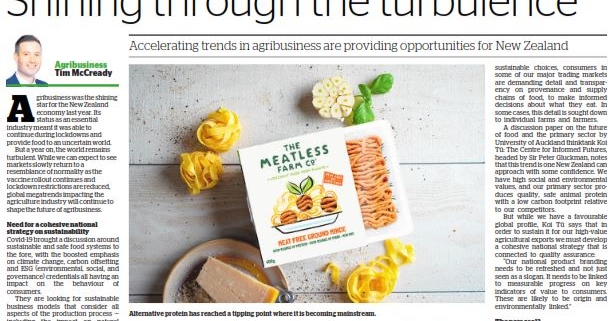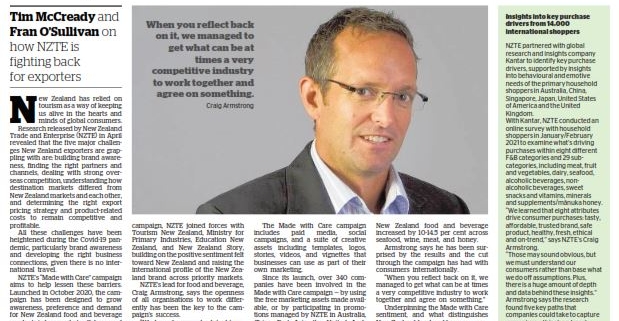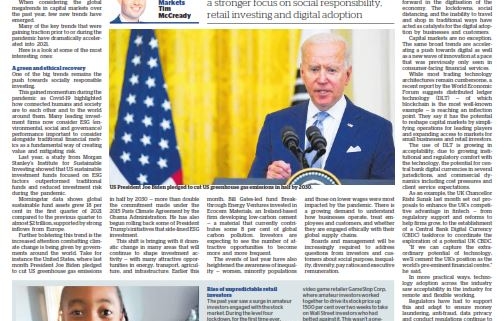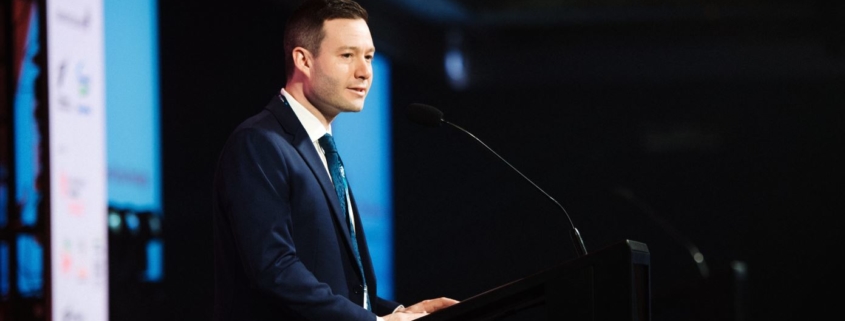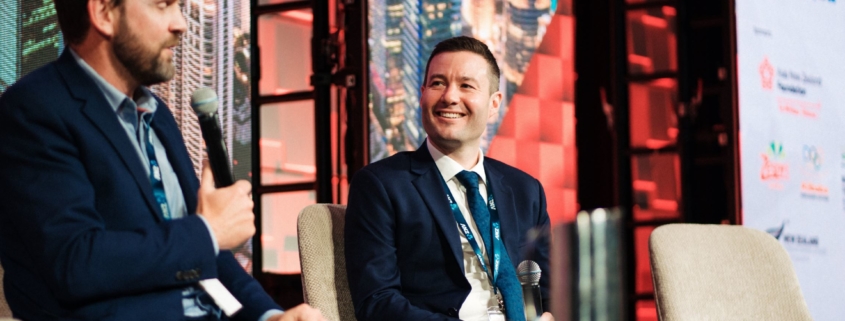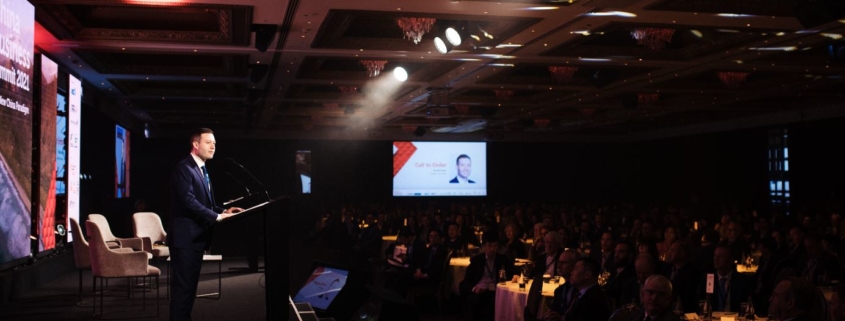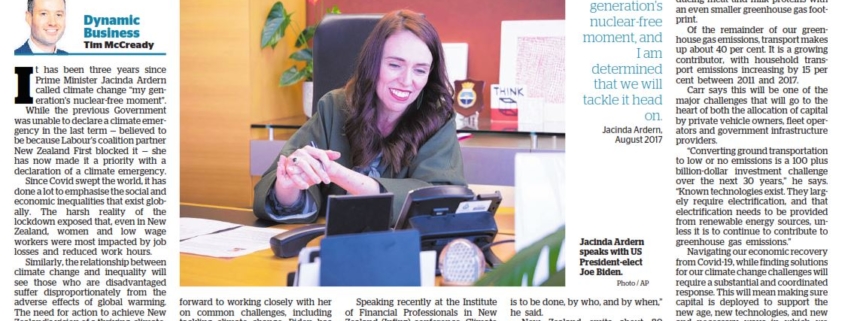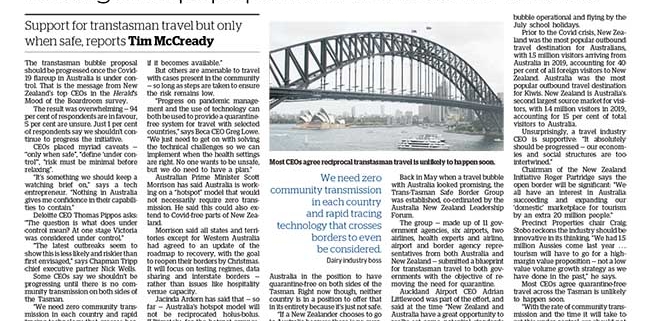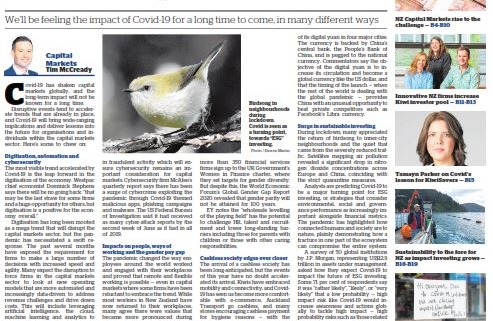Agribusiness Report: Accelerating agri trends providing opportunities for NZ
Agribusiness was the shining star for the New Zealand economy last year. Its status as an essential industry meant it was able to continue during lockdowns and provide food to an uncertain world.
But a year on, the world remains turbulent. While we can expect to see markets slowly return to a resemblance of normality as the vaccine rollout continues and lockdown restrictions are reduced, global megatrends impacting the agriculture industry will continue to shape the future of agribusiness.
Need for a cohesive national strategy on sustainability
Covid-19 brought a discussion around sustainable and safe food systems to the fore, with the boosted emphasis on climate change, carbon offsetting and ESG (environmental, social, and governance) credentials all having an impact on the behaviour of consumers.
They are looking for sustainable business models that consider all aspects of the production process — including the impact on natural resources.
Some developments on this were made last month, with the Climate Change Commission releasing its final report: Ināia tonu nei: a low emissions future for Aotearoa. It lays out a roadmap for New Zealand to meet its greenhouse gas reduction obligations by 2050, and calls for immediate action by government, local government, individuals and businesses.
For agriculture, the Commission says New Zealand needs to reduce its livestock numbers by 13.6 per cent by 2030. It predicts that while New Zealand will still produce roughly the same amount of milk and meat, it will do so with fewer animals, and expects some farms to convert from livestock agriculture to horticulture.
It says low-methane sheep will play an important role (and help cut methane 10 per cent by 2030), along with a reduction in the use of fertiliser, and new technologies will need to come on board, such as vaccines that can help reduce emissions from livestock.
Transparency into provenance and supply chains
As part of making more conscious sustainable choices, consumers in some of our major trading markets are demanding detail and transparency on provenance and supply chains of food, to make informed decisions about what they eat. In some cases, this detail is sought down to individual farms and farmers.
A discussion paper on the future of food and the primary sector by University of Auckland thinktank Koi Tū: The Centre for Informed Futures, headed by Sir Peter Gluckman, notes that this trend is one New Zealand can approach with some confidence. We have high social and environmental values, and our primary sector produces quality, safe animal protein with a low carbon footprint relative to our competitors.
But while we have a favourable global profile, Koi Tū says that in order to sustain it for our high-value agricultural exports we must develop a cohesive national strategy that is connected to quality assurance:
“Our national product branding needs to be refreshed and not just seen as a slogan. It needs to be linked to measurable progress on key indicators of value to consumers. These are likely to be origin and environmentally linked.”
The new coal?
Although it may seem extreme, the growing awareness from consumers of the environmental impact of the food they eat means that some are predicting beef to become “the new coal”.
Alternative protein has reached a tipping point where it is becoming mainstream, with plant-based options such as Beyond Meat and the Impossible Burger increasingly common on restaurant menus and in supermarkets. Last year around 13 million metric tonnes of alternative proteins were consumed globally — including those from plant-based ingredients, cultured meat products, and alternative sources such as insects. This represents around 2 per cent of the animal protein market.
Boston Consulting Group (BCG) believes by 2035 — when alternative proteins reach full parity in taste, texture, and price with conventional animal proteins — 11 per cent of all the meat, seafood, eggs, and dairy eaten around the globe is very likely to be alternative.
This could save as much carbon dioxide equivalent as Japan emits in a year, conserve enough water to supply London for 40 years, and promote biodiversity and food security.
In late 2020, Singapore gave the world’s first regulatory approval for meat that doesn’t come from slaughtered animals. Eat Just’s chicken meat is grown from animal muscle cells in a lab, and the company says this “breakthrough for the global food industry” is one it expects other countries to follow.
New Zealand innovators are working to meet this growing demand for alternative protein. Auckland-based Sunfed Meats recently launched its Bull Free Beef product made from vegetables and cocoa butter, alongside its range of other plant protein “meat analogues” including Chicken Free Chicken and Boar Free Bacon.
FoodHQ, which represents NZ’s food innovation organisations, said in a recent report that emerging proteins are a diversification opportunity that could complement New Zealand’s traditional animal-based protein sectors.
“While our dairy products, meat, wine, apples and kiwifruit will underpin NZ’s food exports for many years to come, we must explore the opportunities to continue adding diversity to our food product offering in order to meet global demand,” says FoodHQ chief executive Abby Thompson.
Tech to boost productivity and reduce emissions
Sensors, robotics, big data and artificial intelligence are other technologies shaping the future of food production and farming.
They all contribute to what is known as precision agriculture, which was already becoming mainstream before the pandemic, but has in the past year demonstrated its importance in creating resilient farming systems.
A local example that integrates several of the above-mentioned technologies is Halter — a company developing a smart collar for fence-free animal management. Last month, Halter secured $32 million in a Series B round led by Australian VC firm Blackbird Ventures (supported by current shareholders including Rocket Lab’s Peter Beck).
The collars, loaded with Bluetooth, GPS and solar panels, allows farmers to virtually herd their stock from anywhere by using an app on their smartphone. Sound and vibration help direct cows, and the collar can also monitor the wellbeing of the animals by detecting unusual movement which might indicate if it is lame or on heat.
The technology works well with NZ’s farming system, as well as other regions that put an emphasis on free-range, pasture-based farming such as Europe and South America.
As new technologies like Halter emerge and farms become better connected to digital infrastructure, the use of precision agriculture and other technologies in agriculture will dramatically accelerate.
These technologies will play a critical role in helping the industry operate with more resilience, increase food security, boost productivity and reduce emissions in farming systems. All of these are integral aspects of the megatrends shaping a sector that is so important to New Zealand’s economy now and into the future.

